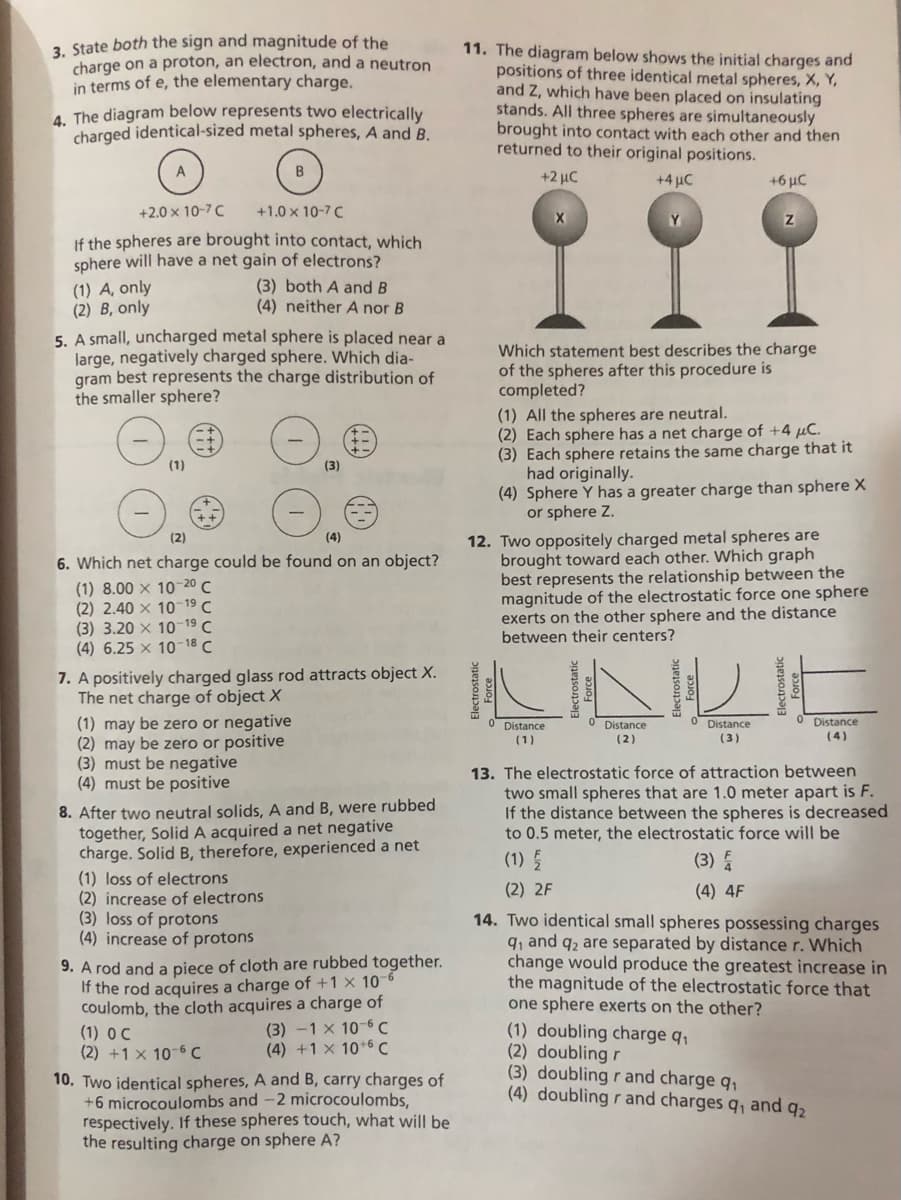3. State both the sign and magnitude of the charge on a proton, an electron, and a neutron in terms of e, the elementary charge. 4. The diagram below represents two electrically charged identical-sized metal spheres, A and B. B +2.0 x 10-7C +1.0 x 10-7C If the spheres are brought into contact, which sphere will have a net gain of electrons? (3) both A and B (4) neither A nor B (1) A, only (2) B, only
3. State both the sign and magnitude of the charge on a proton, an electron, and a neutron in terms of e, the elementary charge. 4. The diagram below represents two electrically charged identical-sized metal spheres, A and B. B +2.0 x 10-7C +1.0 x 10-7C If the spheres are brought into contact, which sphere will have a net gain of electrons? (3) both A and B (4) neither A nor B (1) A, only (2) B, only
College Physics
1st Edition
ISBN:9781938168000
Author:Paul Peter Urone, Roger Hinrichs
Publisher:Paul Peter Urone, Roger Hinrichs
Chapter30: Atomic Physics
Section: Chapter Questions
Problem 2PE: (a) Calculate the mass of a proton using the charge-to-mass ratio given for it in this chapter and...
Related questions
Question
please help with questions 1,2,3,4,5,6,7,8,9,10,11,12,13, and 14

Transcribed Image Text:3. State both the sign and magnitude of the
charge on a proton, an electron, and a neutron
in terms of e, the elementary charge.
11. The diagram below shows the initial charges and
positions of three identical metal spheres, X, Y,
and Z, which have been placed on insulating
stands. All three spheres are simultaneously
brought into contact with each other and then
returned to their original positions.
4. The diagram below represents two electrically
charged identical-sized metal spheres, A and B.
B.
+2 µC
+4 µC
+6 μ
+2.0 x 10-7 C
+1.0 x 10-7 C
If the spheres are brought into contact, which
sphere will have a net gain of electrons?
(3) both A and B
(4) neither A nor B
(1) A, only
(2) B, only
5. A small, uncharged metal sphere is placed near a
large, negatively charged sphere. Which dia-
gram best represents the charge distribution of
the smaller sphere?
Which statement best describes the charge
of the spheres after this procedure is
completed?
(1) All the spheres are neutral.
(2) Each sphere has a net charge of +4 µC.
(3) Each sphere retains the same charge that it
had originally.
(4) Sphere Y has a greater charge than sphere X
or sphere Z.
(3)
12. Two oppositely charged metal spheres are
brought toward each other. Which graph
best represents the relationship between the
magnitude of the electrostatic force one sphere
exerts on the other sphere and the distance
between their centers?
(2)
(4)
6. Which net charge could be found on an object?
(1) 8.00 × 10-20 C
(2) 2.40 × 10-19 C
(3) 3.20 × 10-19 C
(4) 6.25 × 10-18 C
7. A positively charged glass rod attracts object X.
The net charge of object X
(1) may be zero or negative
(2) may be zero or positive
(3) must be negative
(4) must be positive
Distance
O Distance
Distance
O Distance
(1)
(2)
(3)
(4)
13. The electrostatic force of attraction between
two small spheres that are 1.0 meter apart is F.
If the distance between the spheres is decreased
to 0.5 meter, the electrostatic force will be
8. After two neutral solids, A and B, were rubbed
together, Solid A acquired a net negative
charge. Solid B, therefore, experienced a net
(1) loss of electrons
(2) increase of electrons
(3) loss of protons
(4) increase of protons
(1) 5
(3)
(2) 2F
(4) 4F
9. A rod and a piece of cloth are rubbed together.
If the rod acquires a charge of +1 × 10-6
coulomb, the cloth acquires a charge of
(1) O C
(2) +1 x 10-6 C
14. Two identical small spheres possessing charges
9, and q2 are separated by distance r. Which
change would produce the greatest increase in
the magnitude of the electrostatic force that
one sphere exerts on the other?
(3) -1 x 10-6 C
(4) +1 x 10+6 C
(1) doubling charge q,
(2) doubling r
(3) doubling r and charge q,
(4) doubling r and charges q, and q2
10. Two identical spheres, A and B, carry charges of
+6 microcoulombs and -2 microcoulombs,
respectively. If these spheres touch, what will be
the resulting charge on sphere A?
Electrostatic
Force
. Force
Electrostatic
Force

Transcribed Image Text:Review
Questions
1. What is the charge of a proton?
2. A charge of 100 elementary charges is
equivalent to
(1) 9.11 x 10-31 C
(2) 1.67 x 10-27 C
(3) 1.60 x 10-19 C
(4) 6.25 x 1018 C
(1) 1.60 × 10 21 C
(2) 1.60 x 10-17 C
(3) 6.25 x 105 C
(4) 6.25 x 1020 C
116 Topic 4: Electricity and Magnetism
Expert Solution
This question has been solved!
Explore an expertly crafted, step-by-step solution for a thorough understanding of key concepts.
This is a popular solution!
Trending now
This is a popular solution!
Step by step
Solved in 2 steps

Knowledge Booster
Learn more about
Need a deep-dive on the concept behind this application? Look no further. Learn more about this topic, physics and related others by exploring similar questions and additional content below.Recommended textbooks for you

College Physics
Physics
ISBN:
9781938168000
Author:
Paul Peter Urone, Roger Hinrichs
Publisher:
OpenStax College

College Physics
Physics
ISBN:
9781305952300
Author:
Raymond A. Serway, Chris Vuille
Publisher:
Cengage Learning


College Physics
Physics
ISBN:
9781938168000
Author:
Paul Peter Urone, Roger Hinrichs
Publisher:
OpenStax College

College Physics
Physics
ISBN:
9781305952300
Author:
Raymond A. Serway, Chris Vuille
Publisher:
Cengage Learning


Physics for Scientists and Engineers: Foundations…
Physics
ISBN:
9781133939146
Author:
Katz, Debora M.
Publisher:
Cengage Learning

Glencoe Physics: Principles and Problems, Student…
Physics
ISBN:
9780078807213
Author:
Paul W. Zitzewitz
Publisher:
Glencoe/McGraw-Hill

University Physics Volume 3
Physics
ISBN:
9781938168185
Author:
William Moebs, Jeff Sanny
Publisher:
OpenStax